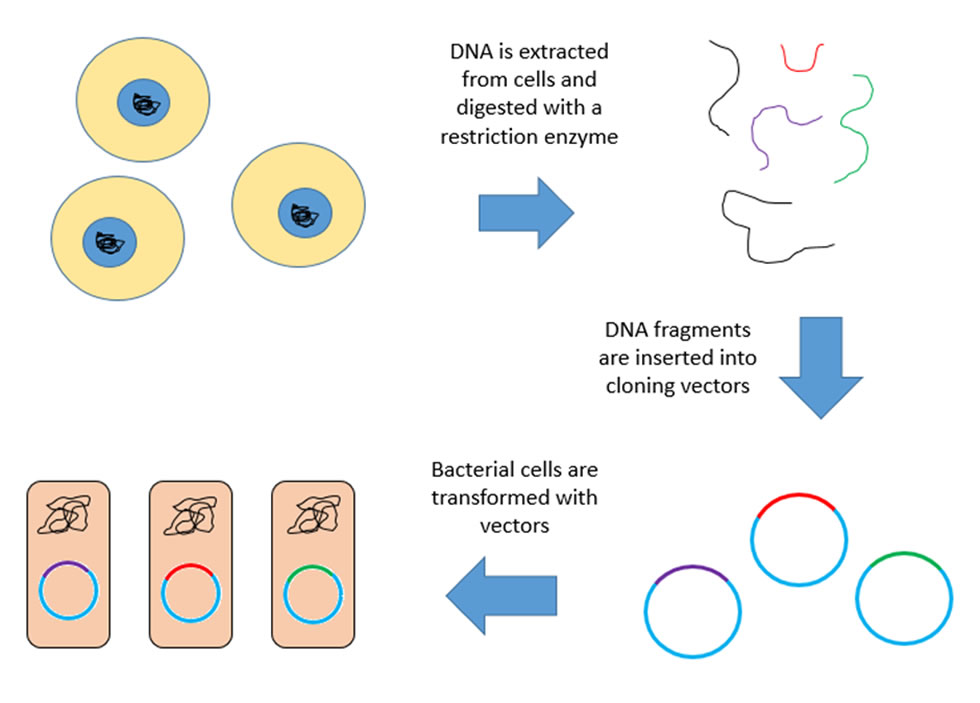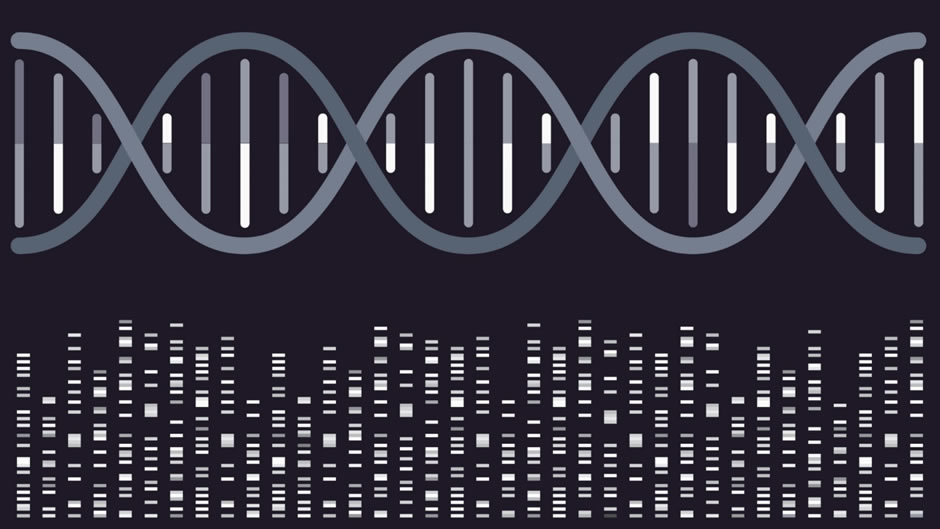DNA sequencing became possible in the late 1970s and has been one of the most influential developments in biomedical research to date. This technology has rapidly expanded since the publication of the human genome in 2003 and genomics is now used in a wide variety of fields. The ability to sequence an organism’s genome has helped to provide genetic tools that can be used to solve a range of complex questions, from applications in medicine where it can be used to predict, diagnose, and treat a range of diseases, to helping prevent crop failures by engineering plants that can withstand environmental stressors.
Genomic Library Construction
The first step in any DNA sequencing project is constructing a genomic library. A genomic library contains all the sequences that are present in the genome of an organism; expressed genes, non-expressed genes, exons and introns, promoter and terminator regions, intervening DNA sequences etc. To create the library, an organism’s genomic DNA is extracted and then digested using a restriction enzyme. Many recombinant DNA molecules must be produced to cover the entire genome.
There are five main steps in gene cloning:
- Isolation of the genomic DNA and vector
- DNA fragment generation
-
-
- Restriction digestion
- Mechanical shearing
-
- Ligation of DNA into a vector system
- Transformation of the recombinant DNA into a host cell
- Library screening

Genomic library construction ( Aluquette via Wikimedia Commons)
Let’s look at each in turn.
Isolation of the genomic DNA and vector
Genomic DNA isolation is an easy technique that can be done following standard protocols or by using a ready-to-use DNA extraction kit. This process includes cell lysis, removal of proteins and impurities, DNA precipitation, DNA purification, and DNA elution. The quantity of the resulting isolated genomic DNA needs to be around 100 micrograms or more and have a purity of around 1.80 at the 260/280 absorbance.
DNA Fragment Generation
Once extracted, the DNA must be broken down into small, random-sized fragments which are carried out using two common techniques: restriction digestion and mechanical shearing. Restriction digestion uses a restriction enzyme that cleaves the DNA into fragments. The enzyme used binds to its specific recognition site, which is present multiple times through the genome and produces fragments that have either sticky or blunt ends. A cutter that produces sticky ends is preferred as these are easy to insert into a vector. An alternative method for fragmentation is mechanical shearing. DNA fragmentation is carried out artificially, producing blunt end cuts. This technique requires an extra processing step to facilitate ligation into the vector.
Ligation of DNA into a vector system
Next, the DNA fragments are incorporated into a suitable vector. Common vectors used for genomic library preparation are plasmid, cosmid, phage, bacteriophage, lambda phage, BAC, or YAC. The vector that you use will depend on the size of the DNA fragment you are trying to clone. For example, a plasmid has a carrying capacity of 15kb of DNA whereas a YAC system can be used for DNA fragments between 250-2000 kb.
Once selected, the vector must be processed to enable the DNA fragment to be inserted. Usually, the vector is digested using the sale restriction enzyme that was used to cut the genomic DNA. The fragment and vector DNA can then be ligated using a ligase enzyme before being sent for transformation. When preparing the vector, it is also important to consider the use of a selectable or screenable marker that can be used to validate the insert, such as an antibiotic-resistant gene.
Transformation of the recombinant DNA into a host cell
The transformation steps involve inserting the recombinant vector into a host cell, such as E. coli or yeast cells, where it replicates to produce copies of the fragments of genomic DNA. Once inserted, the cells are cultured on agar media that contains an antibiotic. This means that only the transformed cells containing an antibiotic-resistant gene can grow.
Library Screening
Library screening is used to identify the genes of interest. The two most common screening methods are colony hybridization and plaque hybridization, and the method you choose will depend on the cloning vector you used. Colony hybridization is a method of selecting bacterial colonies containing the desired genes. This method is used to identify genes in a plasmid- or cosmid-based library. Plaque hybridization on the other hand is used to identify the desired genes in phage-based libraries. Both methods use filter hybridization, enabling the primary screening of libraries by in situ replication on a nitrocellulose membrane.
Applications
Genomic library construction is the first step in any DNA-sequencing project and is vital to research genome structure and function. These libraries have a wide range of applications including SNP analysis, mutational detection, copy number variation studies and population-based genetic studies. Research in this area has helped to identify new genes, find changes in the genome that contribute to disease development, and in the generation of transgenic animals and plants through genetic engineering. In addition, genomics is also frequently being used to study microbial communities and in agriculture for improving the quality and quantity of crop yields.
How We Can Help
Cepham Life Science can provide high-quality custom genomic library construction services to customers around the world. Our highly experienced staff use the latest in technology to offer you high-quality services at an affordable budget. We can prepare genomic libraries from nanogram quantities of genomic DNA or milligram quantities of tissue
Contact Cepham Life Sciences
Cepham Life Sciences offer a quality and comprehensive range of services that can meet all your gene library requirements. Our team of experts will be happy to offer advice and any questions that you have. We are available at our office which is located at 705 Digital Drive, Suite S, Linthicum Heights, MD 21090. You can also reach us by phone at (410) 636-4954 or by email.
Follow us on Twitter, Facebook, Google+, and LinkedIn to keep up to date on all of our products and promotions. If you have any questions, reach out! We would love to hear from you.



